An Inventory of the Historical Monuments in the County of Northamptonshire, Volume 4, Archaeological Sites in South-West Northamptonshire. Originally published by Her Majesty's Stationery Office, London, 1982.
This free content was digitised by double rekeying. All rights reserved.
'Appendix', in An Inventory of the Historical Monuments in the County of Northamptonshire, Volume 4, Archaeological Sites in South-West Northamptonshire(London, 1982), British History Online https://prod.british-history.ac.uk/rchme/northants/vol4/pp177-183 [accessed 1 February 2025].
'Appendix', in An Inventory of the Historical Monuments in the County of Northamptonshire, Volume 4, Archaeological Sites in South-West Northamptonshire(London, 1982), British History Online, accessed February 1, 2025, https://prod.british-history.ac.uk/rchme/northants/vol4/pp177-183.
"Appendix". An Inventory of the Historical Monuments in the County of Northamptonshire, Volume 4, Archaeological Sites in South-West Northamptonshire. (London, 1982), British History Online. Web. 1 February 2025. https://prod.british-history.ac.uk/rchme/northants/vol4/pp177-183.
In this section
APPENDIX
ROMAN ROADS
For ease of reference, all the Roman roads in the area are described here together and not separately under the parishes through which they pass. The roads are identified by the number given to them by I. D. Margary in Roman Roads in Britain, 3rd ed. (1973).
1e and 1f Watling Street, Weedon Bec to Old Stratford (Figs. 129, 130 and 131)
This road, the main Roman route from London to the N.W., enters the area under review in the N.W. corner of Nether Heyford parish (SP 638592). The first part of the road, along the S.W. boundary of Nether Heyford, has been recorded in a previous volume (RCHM Northants., III (1981), p. 208) and this description commences at the point where Watling Street meets the parish boundary between Stowe-Nine-Churches and Bugbrooke, immediately W. of Mount Farm, Bugbrooke (SP 652568). Here the Roman road is on a straight alignment running S.E. from the last change of direction S.E. of Weedon Bec. The modern A5 is in a cutting created in the early 19th century. The modern road itself appears to lie just N.E. of the assumed alignment of the Roman road and the cutting has removed all trace of any former agger.
Immediately to the S.E. the A5 swings E. in a broad arc, partly in a very deep cutting (SP 656563), in order to avoid the steep S. slopes of a broad ridge. The Roman road may have continued straight to the summit of the ridge, perhaps on the line followed by the boundary between Stowe-Nine-Churches and Bugbrooke. However, no trace of an agger exists here or further S. where the land falls steeply. It is possible that the Roman road was on the same line as the A5 at this point, and for the same reason. Whatever the exact position of the road on this ridge, the overall alignment of the Roman road changed slightly, probably about 1½ degrees further S.E.
At the bottom of the ridge the Roman road and the modern A5 are on the new alignment. The modern road crosses the valley on a raised embankment with a small culvert known as Geese Bridge (SP 658557) and the Roman road presumably crossed the stream here by means of a bridge. Beyond Geese Bridge the line of Watling Street is followed almost exactly by the modern road; the latter makes a number of minor deviations but the overall width of the present carriageway and verges has obscured or destroyed any remains of its Roman predecessor.
At the small hamlet of Foster's Booth which lies at the junction of Cold Higham and Pattishall parishes (SP 667539) the modern road swings slightly to the S.W. of the Roman alignment, but the modern houses on the N.E. side of the A5 have obscured any trace of the earlier road.
For the next 4 km. the A5 and Watling Street alignments are almost identical and there is no visible sign of the Roman road. On the N. side of the valley of the R. Tove the modern road appears to lie slightly to the S.W. of the Roman alignment (SP 684503–688494) but the widening of the road over the last 150 years and the planting of copses have again destroyed any possible remains of the Roman agger. Just before the crossing of the R. Tove (SP 689492) the modern and Roman alignments converge. The Roman road must have crossed the river on a bridge.
Beyond the river crossing, the Roman road alignment changes; the road turned 15 degrees to the S.E. to run towards and through the Roman town of Lactodurum (Towcester (3)). The details of the road as it passed through the town are described under Towcester (3) (Figs. 113 and 114). At the S.E. end of Towcester, at the point where the A5 crosses a small N.E.-flowing tributary of the R. Tove on a bridge (SP 694484), the Roman alignment changed again by a further 12 degrees to the S.E. From here to the crossing of the R. Ouse at Old Stratford, a distance of some 11 km., the Roman road remained roughly on this alignment, and is usually followed by the A5. To the S.E. from Towcester the road climbs and then, after 1 km., descends to cross the valley of a small N.E.-flowing stream at Cuttle Mill (SP 718464). Here the modern road swings slightly E., taking an easier line down the valley side. The Roman road certainly ran on and here, for the only time in this region, the original agger of Watling Street is visible. It appears from the S.W. side of the cutting of the A5 as a low bank 10 m.–12 m. wide and 0.5 m. high, running S.E. as the modern road turns slightly E. It is traceable for 200 m. halfway down the valley side but stops abruptly just above the mill-pond of Cuttle Mill (SP 71714653). It seems likely that at this point a bridge continued the line of the road across the deep valley.
Beyond the mill the A 5 returns to the Roman road alignment and climbs the S.E. side of the valley. Thereafter no trace of the Roman road is visible within the county. Between Paulerspury (SP 726458) and Potterspury (SP 756432) the A5 is in places up to 40 m. to the N.E. of the direct Roman alignment but nowhere is there any trace of the Roman road to the S.W. of the A5; it seems that the actual Roman road lay off its theoretical alignment and is under the modern road, perhaps as a result of a slight surveying error.
From Potterspury to the crossing of the R. Ouse at Old Stratford (SP 781410) the A5 is exactly on the Roman road alignment. At the Ouse, which was presumably crossed at a ford, Watling Street passes beyond the boundary of Northamptonshire.
17 Harpole (Fig. 131)
The Roman road from the Roman town of Bannaventa to the large settlement at Duston, just W. of Northampton, crosses the N.E. corner of Harpole parish. The main part of this road has already been described in an earlier volume (RCHM Northants., III (1981), p. 209). The road enters Harpole parish immediately S.E. of Oldfield Thicket (SP 689624) and runs S.E. until it crosses into Northampton at the Sand Lane cross-roads (SP 705618), a distance of 800 m. For the whole of this length the Roman road is obscured by the existing road from Duston to Newbottle and no original features are visible.
160a Whittlebury to Towcester (Figs. 114 and 132)
This Roman road originally ran from the Roman town at Alchester, near Bicester, Oxfordshire, to Towcester. For much of its length in Oxfordshire and North Buckinghamshire the road is still followed by modern roads and tracks, but the part in Northamptonshire has been almost entirely abandoned.
The road enters the county near the S.W. corner of Whittlebury parish, just S.E. of Chapel Copse (SP 684420), within Whittlebury Park. Here a well-preserved agger 11 m. wide and 0.75 m. high even though ploughed over is traceable running almost exactly N. for a distance of 200 m. (air photographs in NMR). It then fades out as it crosses the line of a small E.-flowing stream, now culverted. The agger reappears on the same alignment 400 m. further N., within Cheese Copse (SP 684427), though it is much damaged by trees and is only a very slight ridge 0.25 m. high and some 10 m. wide. Nothing is visible in the modern arable land to the N. of Cheese Copse but on air photographs (RAF VAP CPE/UK/1926, 5232–3) a faint linear cropmark continues the alignment across the valley of a small N.E.-flowing stream, over a low spur and into another N.-draining valley (SP 684430–684435). Thereafter all trace of the road is lost for just over 2 km. If it continued on the previous alignment it should have crossed the Whittlebury to Silverstone road just E. of Doves Farm (SP 683444) until it reached the sharp bend in the main A43 Northampton to Brackley road (SP 684460). At this point the road turned N.E. through some 15 degrees. The short straight section of the A43, in the centre of the bend, is apparently the first 100 m. of the new alignment beyond which a pair of parallel ditches 20 m. apart visible for 700 m. on air photographs (held by Northants County Council; SP 68454610–68664677) is the continuation of this alignment. For the next 500 m. no trace has been noted but then patches of stone (at SP 68804730 and 68964778; inf. T. Shirley), still on the new alignment, probably represent the road.
To the N.E. the road has been recorded during excavations and observations on the extra-mural settlement of the Roman town in 1974–6. At a point where the road crossed marshy ground (SP 69034800) it was shown to consist of a strip of gravel 10 m. wide and up to 15 cm. thick, laid directly on the sub-soil, with a shallow ditch on the S.E. side. This was filled with material containing 1st-century pottery and efforts had been made to retain the metalling with wooden stakes. Later the width of the metalling was halved to 5 m. and again retained with stakes.
Further N.E. a length of 170 m. of the road was extensively trenched (SP 69044804–48994788). It consisted mainly of gravel 8 m.–10 m. wide, again laid directly on the sub-soil. The number of side ditches varied, there being usually two on the S.E. and three on the N.W. They contained pottery ranging from the 2nd to the 4th centuries (Northants. Archaeol., 11 (1976), 194; Notes by C. Woodfield in NMR). Some 140 m. further to the N.E. a layer of hard packed gravel was seen on the same alignment during road construction in 1967 (SP 69004817) and is presumably its continuation (inf. D. C. Mynard). For the details of this road within the defended area of Towcester, see Towcester (3).
During the excavations in 1975 a short length of another road was discovered running S.E. from the Alchester road for at least 100 m. (from SP 69044803). It consisted of a thin strip of gravel 6 m. wide flanked by small side ditches. It has been suggested that it was of 3rd or 4th-century date (Northants. Archaeol., 11 (1976), 194).
161a Aynho to Warkworth
A Roman road, known as the Port Way, is alleged to have run N.W. from Akeman Street at Kirtlington in Oxfordshire. There is no real proof that this was a Roman road, and if it was then it is likely to have been a minor one. The route described enters Northamptonshire near the S.E. corner of Aynho Park (SP 522322) and crosses the park as a modern track to meet the Aynho to Croughton road just E. of Aynho (SP 518333). The track lies on top of ridge-and-furrow in places and has no visible signs of antiquity. Beyond the Croughton road, the line of the Port Way is followed by an enclosure road and, beyond the Aynho to Charlton road (SP 516335), by a track, deeply hollowed in places, as far as the deserted village of Walton (King's Sutton (10)). This part is by no means straight and, whatever its origin, was in medieval times the main route S. from Walton. At Walton the hollow-way crosses a small stream and is lost. It is said to have continued N.W. to King's Sutton and from there along the E. side of the R. Cherwell via Twyford (SP 488373) where another postulated road, 56a, is said to have crossed it. The Port Way is then assumed to have run on through Warkworth parish to Hanwell in Oxfordshire. No traces of an original road can be seen on this route N. of Walton.
166 Syresham to Boddington
This is said to be part of a Roman road from Bletchley in Buckinghamshire to Wormleighton in Warwickshire. The S. part, in Buckinghamshire, has been tentatively identified (The Viatores, Roman Roads in the S.E. Midlands (1964), 309, 314), but its extension via Syresham, Helmdon, Sulgrave, Culworth, Aston le Walls and Lower Boddington is very doubtful (Cake and Cockhorse, 2, No. 7 (1964), 119).
56a King's Sutton to Evenley
There is good evidence that a Roman road ran S.W. across north Oxfordshire from the Fosse Way and it has been traced as far as Tadmarston, near Banbury. It is then said to have crossed the R. Cherwell near Twyford into King's Sutton parish and thence to have run eastwards via Astrop, Charlton and Evenley, crossing back into Oxfordshire at Finmere to meet the Roman Road 16a. Though a section through a Roman road is said to have been exposed in Astrop Park, the straight roads that follow much of the alleged route are enclosure tracks and show no visible signs of antiquity. (Cake and Cockhorse, 2, No. 7 (1964), 117)
Towcester to?
In 1967 a trench, cut roughly N.-S. across the public footpath running immediately S. of the road, S.W. of Towcester (SP 684484), revealed a feature described as a Roman road. Four separate layers of construction were recognised and there was a sherd of Nene Valley pottery in the top layer. (BNFAS, 3 (1969), 2)
Deanshanger to Cosgrove
There is said to be a Roman road from Water Stratford, Buckinghamshire, to Irchester, passing through Deanshanger. Old Stratford and Cosgrove. Though recorded in some detail the evidence for it is unconvincing. (Wolverton and District Arch. Soc. Newsletter, 5 (1960))
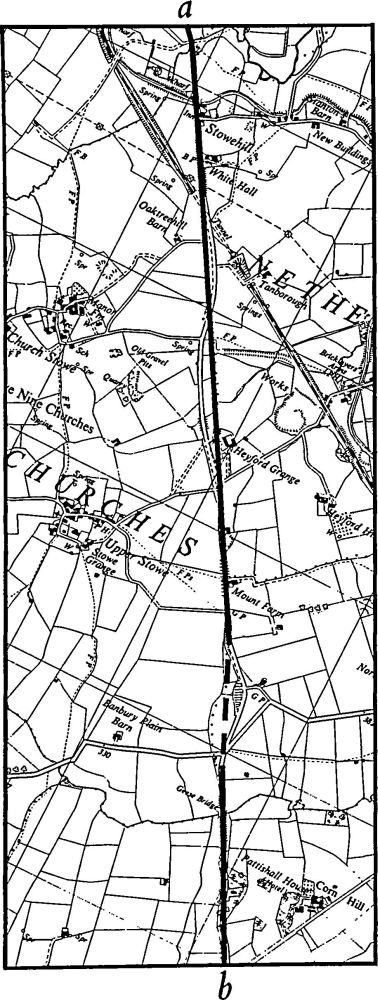
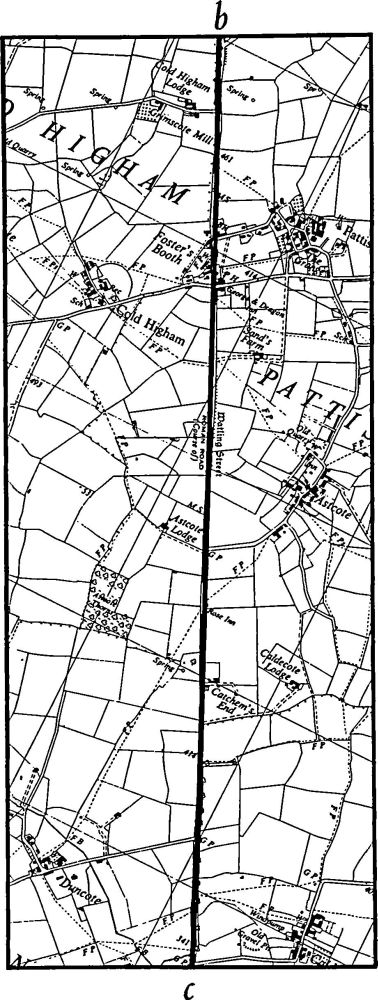
Fig. 129 Roman Road 1f, Watling Street Weedon Bec — Greens Norton
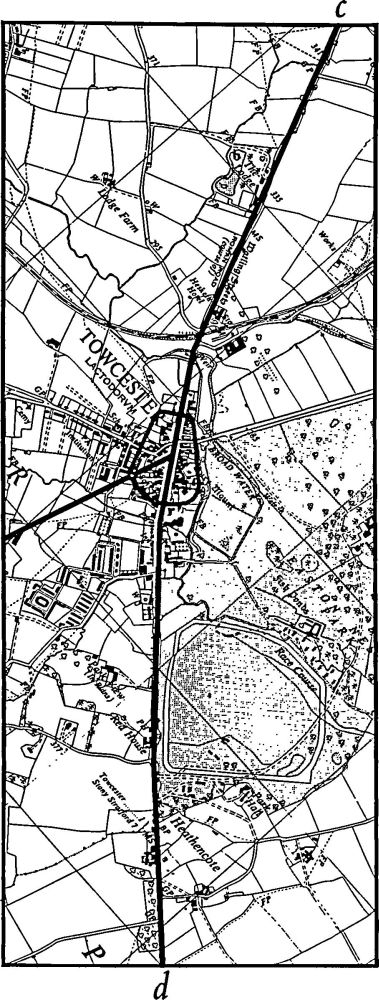
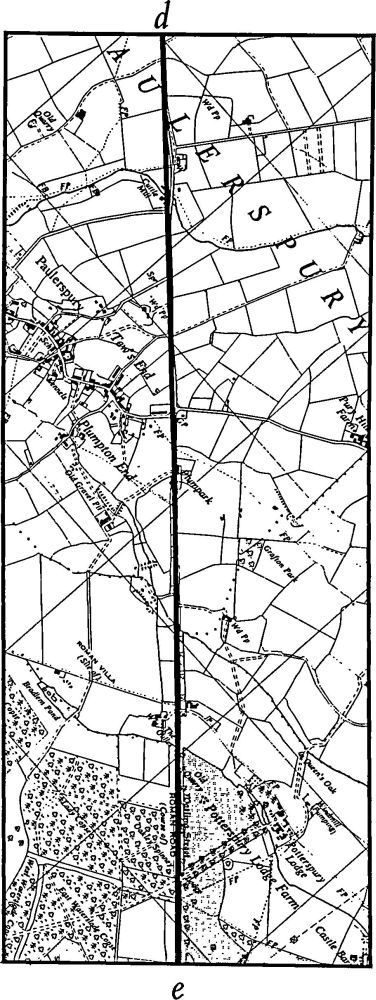
Fig. 130 Roman Road 1f and 1e, Watling Street Greens Norton — Potterspury

1e, Watling Street, Potterspury — Old Stratford
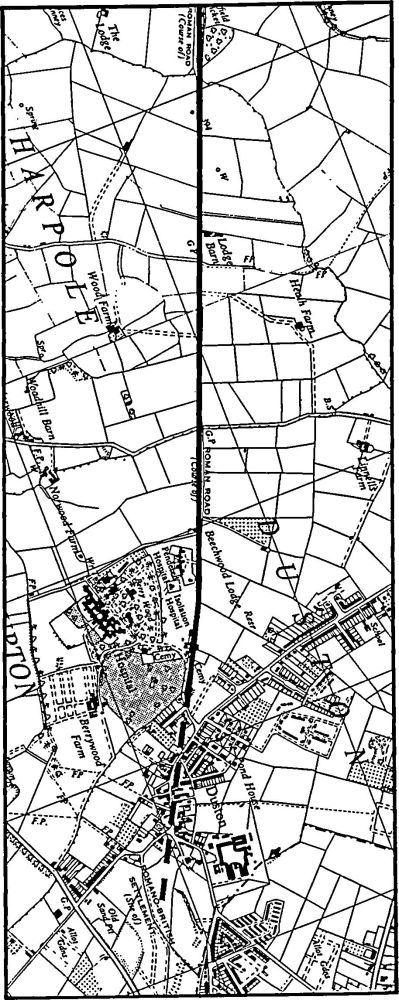
17 Harpole — Duston
Fig. 131 Roman Roads
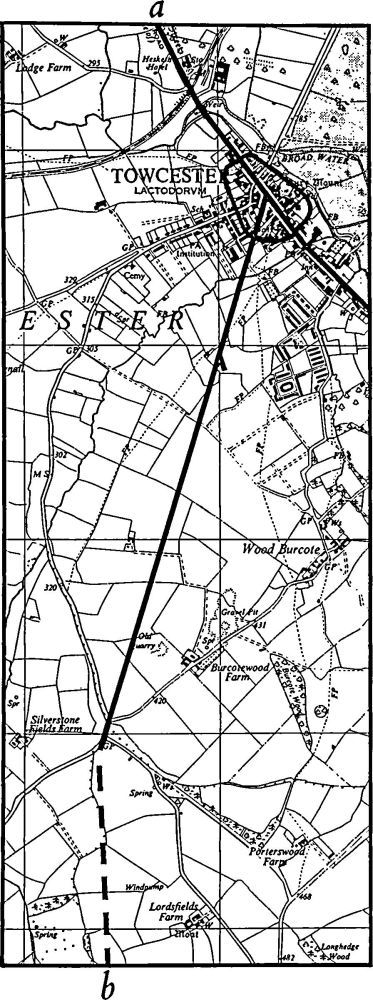
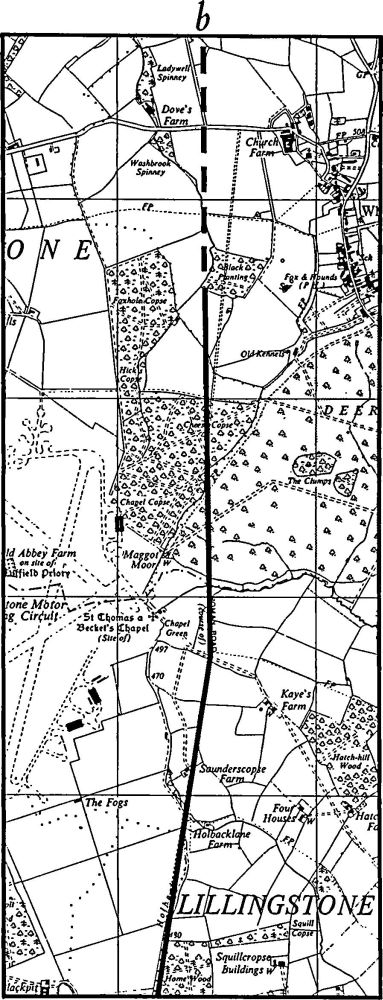
Fig. 132 Roman Road 160a, Whittlebury — Towcester
